It's that time of year again – the time when people travel to the far northern reaches of the world in hopes of seeing the elusive aurora borealis; the Northern Lights.
I've been on a couple Northern Lights-seeking missions in the past decade. In Iceland. In Canada. In Arctic Norway. Not all my forays have been successful (I've yet to see them in Iceland despite two separate winter trips there), but I've learned a lot about this phenomenon along the way.
And that includes learning all the things that people tell you about seeing the Northern Lights that just aren't true.
There are plenty of myths surrounding seeing the Northern Lights, and I'm here to dispel a few of them for you.
Quick Northern Lights facts
In simplest terms, the aurora borealis is a phenomenon that happens in the night sky. The “Lights” are caused by charged particles given off by the sun during solar storms interacting with the gases in earth's atmosphere.
Here are some quick, fun facts about them:
- Auroral ovals exist over both of Earth's poles, and are thought to mirror each other. Meaning when the Northern Lights are active, so are the Southern Lights.
- The Northern Lights are called the aurora borealis, while the Southern Lights are called the aurora australis.
- Spots within the “normal” northern aurora oval include places like Iceland, northern Norway, northern Canada, and central Alaska.
- After major solar storms, the Lights have been seen as far south as Miami, Florida and Athens, Greece.
- After said solar storms, the charged particles that cause the aurora take 2-4 days to reach Earth.
- The variations in color of the Lights are due to the types of gases the sun particles are colliding with, and at what altitude. The Lights can occur anywhere between 40 and 600 miles above the earth's surface. The more common green color is caused when particles encounter oxygen about 60 miles above the earth. Red is caused by oxygen, too, but at much higher altitudes. Nitrogen produces blue and purple tinges in the aurora.
- The shapes the Northern Lights make in the sky are determined by fluctuations in the earth's magnetic field.
- The Lights are usually most active after midnight.
- Scientists didn't really start studying the Northern Lights (or understand what caused them) until the 1960s!
- Earth isn't the only planet that the Northern Lights appear on – there are even auroral ovals on Saturn!

Actual Northern Lights myths
The earliest recorded sighting of the Northern Lights can be found in ancient Chinese literature, and countless native populations came up with their own explanations and beliefs about the Lights long before scientists and astronomers ever got involved.
Some of my favorite aurora-related myths include:
- The Norse used to believe the Lights to be reflections off the shields of the Valkyries, who led dead soldiers to the afterlife.
- In Southern Europe, the Northern Lights were feared and believed to be a sign that war was coming since they are so rarely seen so far south.
- The Alaskan Inuit people, too, viewed the aurora as dangerous, and would wave sharp knives and throw dog poo at the Lights to make them go away.
- In Iceland, it was believed that a pregnant women who looked that the Lights would give birth to a cross-eyed baby.
- Conversely, in Japan and China, the Northern Lights were seen as a sign of fertility, and a baby conceived beneath them would have good fortune in life.
- In Scandinavia, the lights were also good luck – the display in the sky was believed to be caused by light reflecting off herring in the sea, meaning good fishing was to be had.
- Similarly, farmers in Sweden saw the Lights as a promise of a rich harvest.
And, in case it needs to be said, the Northern Lights are not dangerous! Despite some of the cultural myths surrounding them, the aurora is a scientific phenomenon that is not harmful for humans to watch or be exposed to.
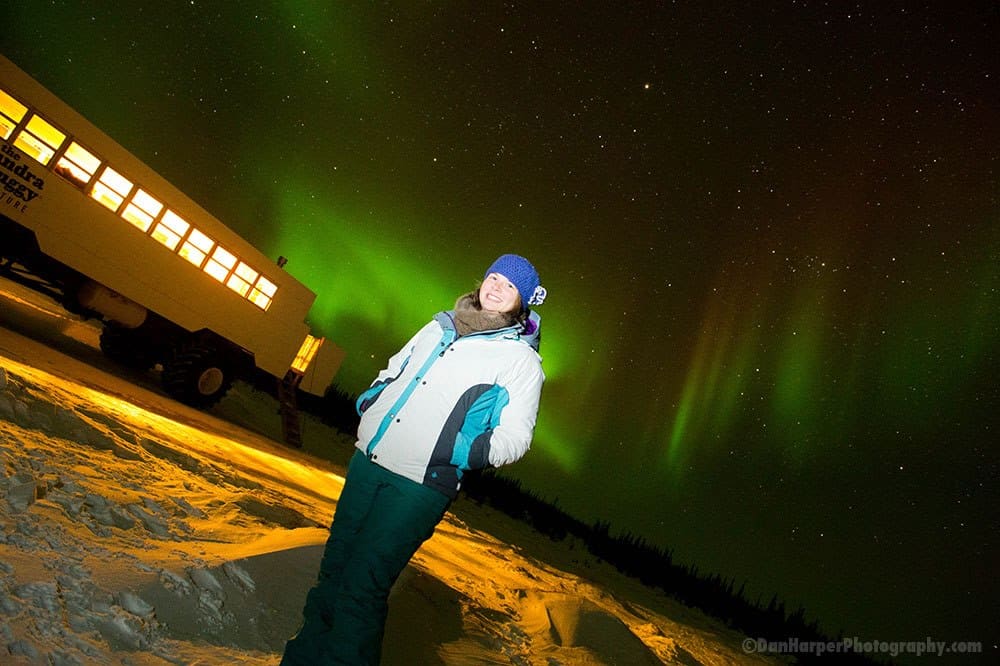
9 lies people tell you about seeing the Northern Lights
Don't listen to the following myths about seeing the Northern Lights:
1. You won't see the Lights for the next several years
At the end of 2015, a frantic rumor was circulating around on the internet that the Northern Lights were going to disappear for the next decade or so. Countless news outlets reported that it was your “last chance” to see them for the next ten years. (And I suspect that we'll start hearing similar doom-and-gloom warnings in 2025!)
This simply isn't true. What IS true is that the aurora is affected by solar activity and more or less follows an 11-year solar cycle, with solar maximums at each end. But the Lights can't just be “turned off.”

So, while it's predicted that the Lights will reach a peak in the current solar cycle from 2024-2025, it does not mean that this is the ONLY time you can see them in the coming years.
2. The Lights are only visible in the winter months
Winter is a popular time to see the Northern Lights, but that doesn't actually mean it's the only time of year that you can see them. The aurora borealis is not a seasonal phenomenon; it occurs based on solar particles interacting with the gasses in our atmosphere – and this literally happens year-round.
You usually can SEE the Lights best in the winter months simply because those months have more hours of darkness per day, and darkness is one of the necessary conditions for seeing the aurora.

Ask any northerner, though, and they'll tell you that they will sometimes spot the Lights at night as early as August each year, and into April the next. (September through March is generally regarded as Northern Lights “season” in most places.)
Looking for more Northern Lights content?
Check out these other Northern Lights-related posts:
3. You can't see the aurora if the moon is shining
The best conditions for seeing the Northern Lights include a couple key factors: Mainly dark skies, and very few clouds. And, usually, the less light pollution in the sky, the better. This leads many people to profess that you won't see the aurora if the moon is shining brightly.
While it's true that a full moon can “dim” the Lights a bit, it certainly doesn't negate your chances of seeing them entirely.

In fact, one of the best Northern Lights shows I've seen yet was on a night that included a bright almost-full moon in Norway.

RELATED: Chasing the Northern Lights in Arctic Norway
4. Clear, dark skies guarantee a sighting
Along a similar vein, many people assume that since aurora “conditions” require clear, dark skies, this means that clear, dark skies will always produce a Northern Lights show. I wish I could say this was true, but it unfortunately isn't.
Sky conditions have nothing to do with the aurora borealis (remember, the Lights are caused by solar particles interacting with elements in our atmosphere, not weather conditions). The chemical reaction that happens up there in the sky happens regardless of cloud cover – we just can't see it happening when it's too cloudy.

I've seen the Northern Lights on cloudy nights AND clear nights – and I've also failed to see them on both cloudy nights and clear nights. You'll of course always have a better chance of seeing them if the skies are clear, but don't always count on it!

5. You shouldn't book a guided Lights-chasing tour
A lot of independent travelers turn their noses up at guided tours, insisting that doing their own thing always leads to better experiences. While this may be true in many cases, I really don't think it applies when it comes to the Northern Lights.
In order to see and truly appreciate this natural wonder, you really need to be with someone who knows a bit about “chasing” the Lights. Someone who can puzzle out the weather forecast, read the KP index, and understand when you should stay put and when you should move on to a different location in hopes of catching a Lights show.
Plus, guides generally have friends who are also guides, and many of them talk when out hunting the aurora. Which means that if there's a good sighting elsewhere, chances are your guide will hear about it (and then hopefully take you there).

I'm not saying that you CAN'T go Northern Lights chasing on your own – of course you can. But if you want the best chance of seeing them (and want to learn a bit more about them, and potentially even get some photography tips), I highly recommend booking a guided tour.
Northern Lights guides are usually huge fans themselves, and will do everything possible to make sure you have the best chance of seeing them. (For those who are tour-averse, simply look for ones that advertise small groups instead of big coach buses.)
6. If tours are running, you'll see the aurora
My tour recommendation comes with a caveat, though: just because tours are running on a particular night in no way guarantees an aurora sighting.
Most companies will cancel tours if the weather forecast looks terrible (i.e. completely cloudy skies with little chance of a break), but they can never guarantee a sighting in good weather (natural, scientific phenomenon, remember?).
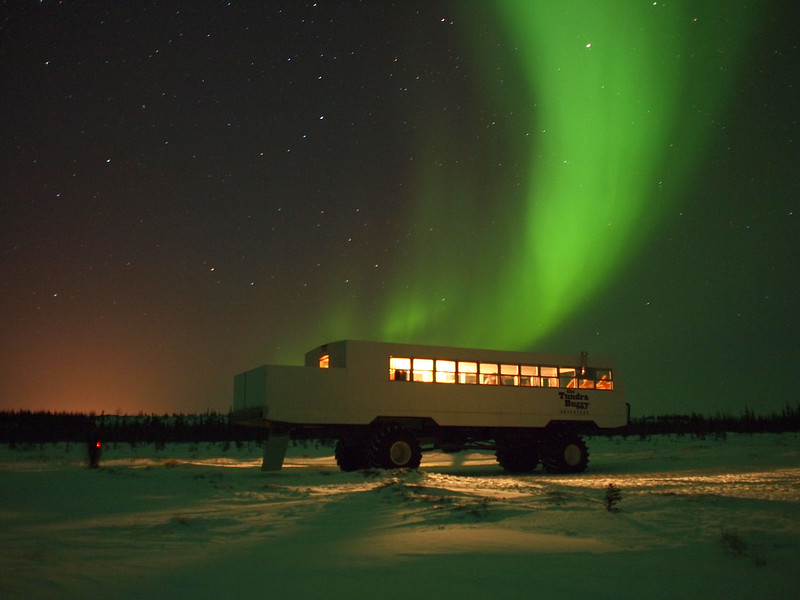
It's of course more *likely* that you'll see the Northern Lights on a night that various Lights-chasing tours are running, but never consider it a guarantee. (I've been on two Northern Lights tours where we never saw anything; many companies will let you re-book on a second night for free if this happens to you.)
7. You should always plan around the Kp-index
The Kp-index (officially the Planetary K-index) is essentially the closest thing to a Northern Lights forecast that we have. It measures geomagnetic storm strength on a scale of 0 to 9, and the numbers correspond to the strength (and brightness) of any possible aurora.
The higher the Kp-index number, the better the chance of a good aurora show.
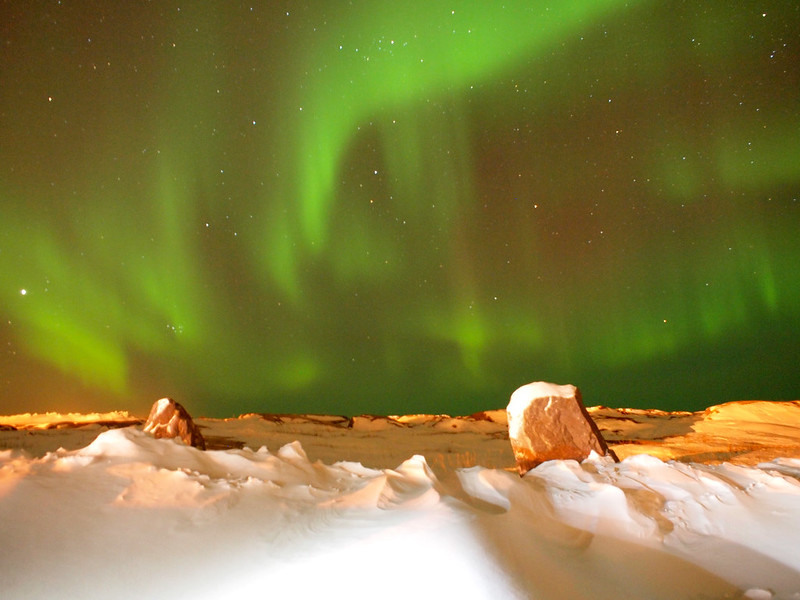
But, as with any type of forecasting, you don't want to rely completely on the Kp-index. You might get an amazing showing on a night when the Kp-index is only supposed to be at a 2, and you may get nothing on a night when the Kp-index is at a 4 or 5.
If you have the option of going Northern Lights chasing on a night with a Kp-index of 7 vs. another night with a Kp-index of 1, I'd definitely go with the 7. But that doesn't mean you have no chance of seeing them when the index is at a 1 or 2, either, especially if the skies are clear.
8. You don't need a good camera
If the aurora is strong enough, you WILL be able to see it with your naked eye with no question about what you're looking at. But when the aurora is weaker, it's sometimes tricky to differentiate between wispy clouds and the Northern Lights.
A good camera, however, can pick up a lot more light and color than our human eyeballs can at night. This is why you do really want a good camera with you if you're going to be chasing the Northern Lights.

A “good camera” doesn't need to be super expensive, though. Ideally, it needs to be one with a manual mode so you can set your shutter speed (how fast a photo is taken) and aperture (how much light is let in) on your own.
A slow shutter speed (anywhere from 5 to 30 seconds) and small aperture (the lower the number, the better) are what you're going for – and you'll want a tripod to put your camera on in order to avoid camera shake.
I've shot the Northern Lights with an Olympus PEN E-P2 and an Olympus OM-D E-M5 Mark II, and got photos I was happy with both times. (I now have an even “fancier” Sony A7iii, but haven't gotten to shoot the aurora with it yet!)
RELATED: Tips for How to Photograph the Northern Lights
9. They will look just like they do in all the photos
Hopefully if you've made it to this part of the post, you'll already know that this isn't true. So many factors go into a Northern Lights “show,” and no two nights are ever the same.
One night you may get an amazing, strong, and long showing of the aurora, while the next you may get nothing more than a dark sky. Some nights you'll be able to see greens and reds clearly with the naked eye, while other nights you'll struggle to see any color at all.
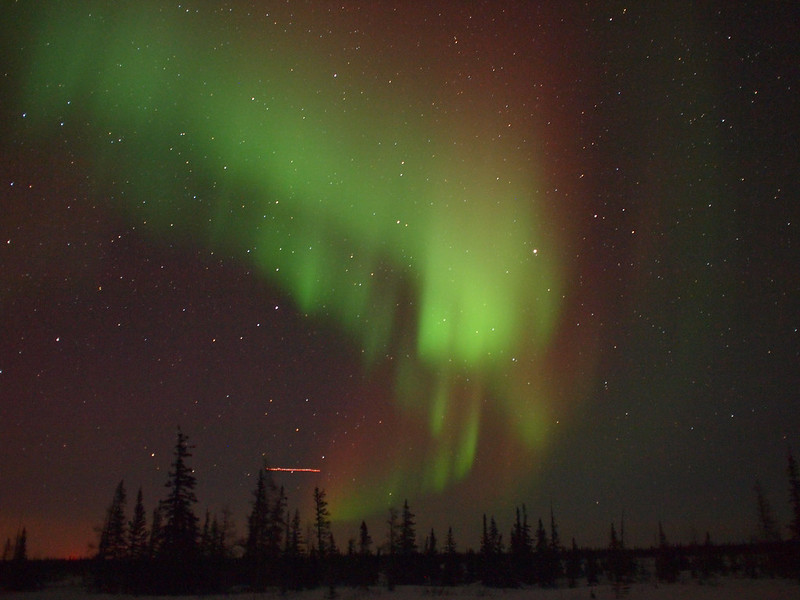
There's no guarantee that the Northern Lights you see will look anything like all those amazing photos you've seen online – but I would still recommend going, because there's of course never any telling what you WILL see!
(Conversely, you can also ignore anyone who claims that you CAN'T see the Northern Lights with the naked eye. On some nights when the lights are weak, it can be true. But on other, stronger nights you definitely CAN see the aurora with the naked eye. Again, though, every night is different!)
One Truth about the Northern Lights
The one truth people will tell you about seeing the Northern Lights is this:
Once will never, ever be enough.
Once you've caught that aurora borealis bug, prepare to always want more. I've been out with people who have been Lights-chasing for decades, and they're always still so excited when that first hint of green dances across the sky.
The Northern Lights may not *actually* be magical, but they certainly can work like magic on people who see them.

Essential Northern Lights info
- Looking for packing suggestions for a Northern Lights-chasing trip? Head over to my Northern Norway packing list to get some ideas for winter must-haves.
- Pick up a Northern Lights travel guide to help you plan your trip.
- Along with a camera you can set to manual mode, you'll need a tripod, a shutter release, and probably some extra batteries!
READ NEXT: A Perfect 10-Day Itinerary for Norway in Winter
Is seeing the Northern Lights on your bucket list? Or have you seen them yourself and discovered any of the “lies” on this list?
Pin it for later:
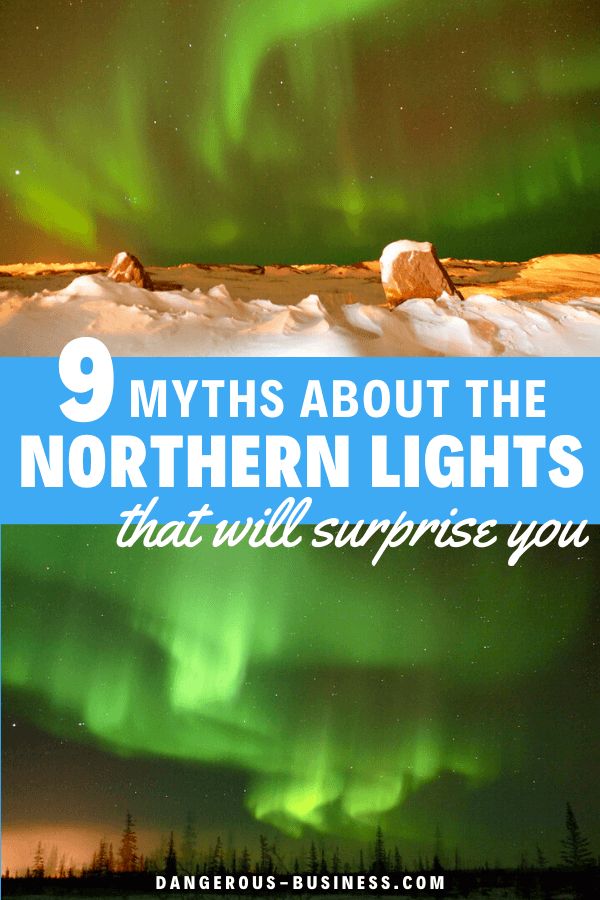
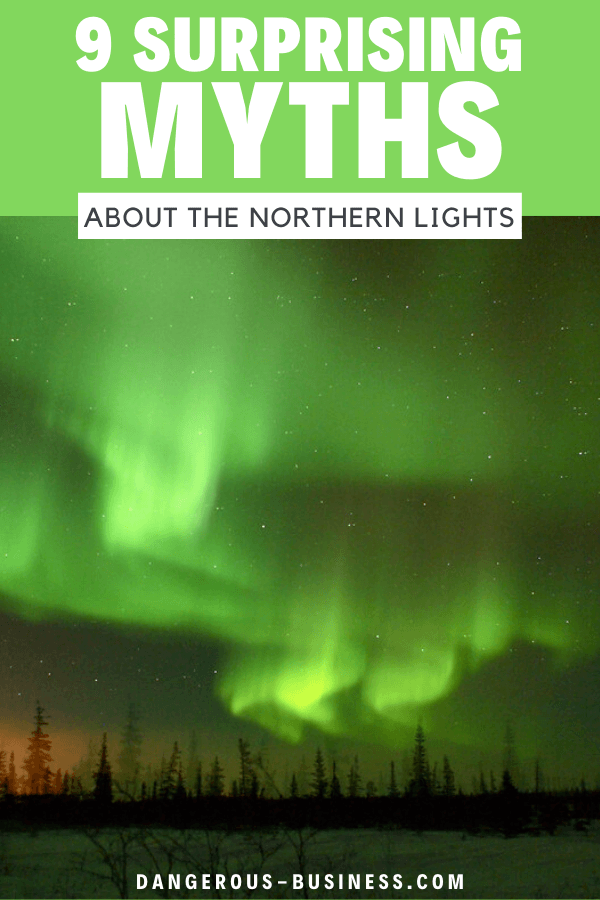

Amanda Williams is the award-winning blogger behind A Dangerous Business Travel Blog. She has traveled to more than 60 countries on 6 continents from her home base in Ohio, specializing in experiential and thoughtful travel through the US, Europe, and rest of the world. Amanda only shares tips based on her personal experiences and places she's actually traveled!










We’ve seen only once in Iceland and it is true that you just cant have enough of it) And indeed sharing this experience via pictures or videos is extremely challening due to shooting conditions/camera constraints. Congratulations on your pics, really nice!
Thanks Denis! I think chasing the Northern Lights will be something I’ll always want to do – I can’t imagine ever getting bored of it!
These pictures are amazing–great job! I, too, missed out on the Lights during my trip to Iceland. You’ve seen some really good ones–kudos!
I’ve been very lucky to see them in other parts of the world – but I still dream of seeing them in Iceland some day, too!
I have never seen the Northern Lights, despite living in Northern Canada and having friends and family members see them many times.
I REALLY want to go to Churchill to see them, but it is so expensive to get out there.
Hopefully I get to go sometime soon!
Yeah, Churchill is not an easy place to get to! Have you looked into taking the train? I’m not sure how much cheaper it is, but it would certainly be an experience! Haha. I hope you get to see the Lights soon!
Yes! Seeing the Northern Lights are on my bucket list!
I’d say they definitely deserve a spot on that list!
I so agree with your truth. Once you see them, you will be hooked! I can’t wait for my next adventure to see them again. I would like to try one of the glass igloo hotels in Finland. Just watch them from the warmth of your bed 🙂
One of my favorite (unplanned) sightings was at the Holmen Husky Lodge in Alta, Norway. We went dogsledding at night, and stayed overnight in these really cool lavvo tents (though these were made from glass and wood). You couldn’t see the Lights from the tents themselves, but we did catch a glimpse of them above the tents – it’s one of my favorite photos!
And yes… once is never enough with the Northern Lights!
Northern Lights are on the list for sure, but it’s not an easy thing to tick from that list. 🙂 However last year or so there was a night when Northern Lights were seen even in Eastern Europe – we’ve just heard it and seen the pictures while we were on the other part of the world. That’s life. 😀 😀
You’re right – it’s not as easy to tick off of that bucket list as some people would think! But even just trying can be really fun. 🙂
So jealous of these photos! The Northern Lights elude me – I seem to have just missed them on my last two trips to the Upper Peninsula in Michigan. Of course, in the summer, I have trouble staying awake long enough past dark!
I follow the Great Lakes Aurora Hunters on Facebook – members post some really great shots from Minnesota, Wisconsin and Michigan.
It would be great to see them in the US, but really good sighting are so rare this far south!
Your photos are amazing! It’s kind of funny because I’ve just been travelling for 18 months seeing incredible things, I even went to Iceland a couple of years ago and didn’t catch the northern lights. And I’ve come home to northern Scotland to wind down for a bit – and I saw the northern lights within two days of getting home!! It’s hard to believe such a phenomenon is on my doorstep, there’s a local Facebook group dedicated to aurora sightings and photos and some of the pictures people post are just phenomenal. I agree, ignore all the “you won’t see them for the next x number of years” because they still seem to be as strong as ever!
However, I do need a better camera! 🙁
Ahhh I would love to see them in Scotland!! Lucky you that you were able to catch them!
Seeing Northern lights are way up on my bucket list, I simply have to see it for myself.. And thanks especially for the camera advice! Wonder if my Canon G7 X is going to cut it..
If your camera has a manual mode (i.e. you can set the shutter speed yourself), then it actually might be fine! Digital cameras have come such a long way in recent years!
I have always wanted to see the northern lights! It is definitely on my bucket list 🙂 Great article!
It’s a great bucket list item!
Great post! Luckily I wasn’t surprised by any of your false facts! I’m going to Iceland in mid-November and I’m keeping my fingers crossed that both the Northern Lights and the Ice Caves won’t elude me!
Fingers crossed indeed! I didn’t quite get the ice caves experience I was hoping for last year, but it was still an amazing trip!
Beautiful pictures! This is definitely on my bucket list for the future 🙂
It’s a great bucket-list item! Hopefully you’ll get to check it off soon.
Yes it is, and sadly they’ve always evaded me as I’ve been to the Arctic and Iceland a few times but always in summer or early fall (=no lights). Love this post—so fun and helpful!
Sounds like it’s time for a winter trip, then! 😉
Thanks for the info! I’m heading to Norway and Iceland next week (!!) and this is all good to know. Fingers crossed that we see some northern lights!
Here’s hoping you get a few nights with good conditions!! (If not, though, both Iceland and Norway are still incredible!)
A good tip is to notify the person at the front desk that is working overnight to give you a wakeup call if they see the lights. You may get a call at 2AM. We’ve seen them in Iceland and Norway. WAY COOL. Hope for the best.
Yes, and many hotels offer this service automatically, too, if you’re in a really active area! (Though if you’re staying in a big city, you probably won’t see them as well because of all the light pollution.)
Very nice article about northern lights! As I live in Scandinavia, I have had the chance to experience them many times. It’s true that a camera “sees” them better than the naked eye… When I spotted an aurora borealis for the first time, I was so surprised how much brighter it looked on the picture! That’s why pictures of northern lights are often misleading, especially those of green-red-purple picture-perfect ones that are quite rare and require very strong solar activity… In Europe I recommend Finnish Lapland and Norway’s northernmost coast for northern lights’ chasing. Sometimes they are visible as south as Helsinki, Stockholm, Oslo and even Scotland! The best time to spot them is usually around midnight. Here is a good northern lights’ forecasting website: http://www.gi.alaska.edu/AuroraForecast/Europe/
Northern Canada and Alaska are great for spotting, them, too, but so far Northern Norway has had the best weather for aurora-chasing – they don’t get those bitingly cold winters because of the coastline!
I saw them three nights in a row in Abisko, at the STK hotel and the ski station known as the ‘Aurora Sky’. You are so right about how the cameras (even monitors) exaggerate the lights. I was looking at the lights – looked like a wedge, and shortly after a whitish arc in the sky; at the same instant a japonese tourist was taking a photo of very same thing: an absolute intense greenish ameba hovering in the sky.
I can truly recommend Abisko. for some reason has quite often a very clear sky, no or few clouds
I’ve heard great things about Abisko! Would love to go Northern Lights-spotting there.
And yes, sometimes your eyes can’t capture the color like a camera can. (Though if you’re lucky enough to see a super strong “show,” you CAN see all the colors with the naked eye!)